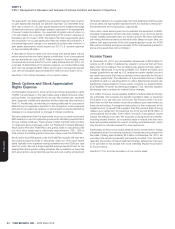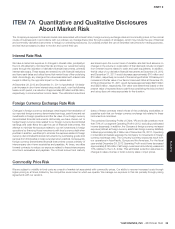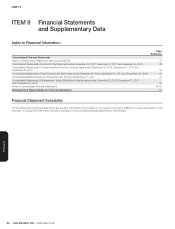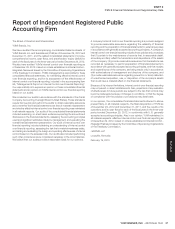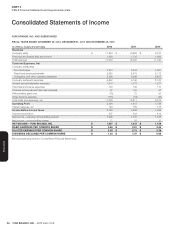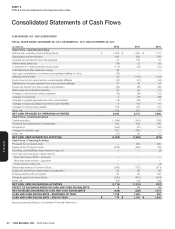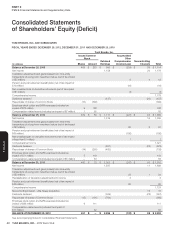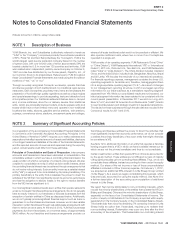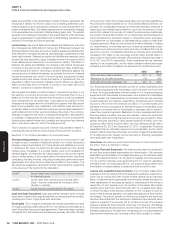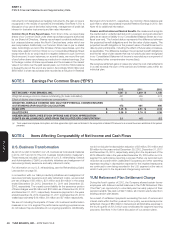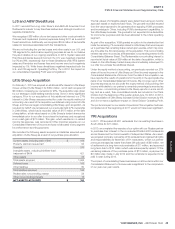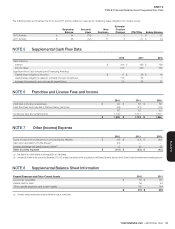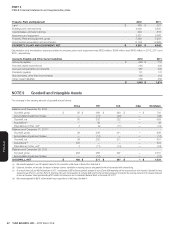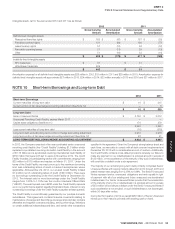Pizza Hut 2012 Annual Report Download - page 136
Download and view the complete annual report
Please find page 136 of the 2012 Pizza Hut annual report below. You can navigate through the pages in the report by either clicking on the pages listed below, or by using the keyword search tool below to find specific information within the annual report.
YUM! BRANDS, INC.-2012 Form10-K 44
Form 10-K
PART II
ITEM 8Financial Statements andSupplementaryData
is classifi ed outside permanent equity and recorded in the Consolidated
Balance Sheet as the greater of the initial carrying amount adjusted for the
non-controlling interest’s share of net income (loss) or its redemption value.
We participate in various advertising cooperatives with our franchisees and
licensees established to collect and administer funds contributed for use in
advertising and promotional programs designed to increase sales and enhance
the reputation of the Company and its franchise owners. Contributions to
the advertising cooperatives are required for both Company-owned and
franchise restaurants and are generally based on a percent of restaurant
sales.We maintain certain variable interests in these cooperatives. As the
cooperatives are required to spend all funds collected on advertising and
promotional programs, total equity at risk is not suffi cient to permit the
cooperatives to fi nance their activities without additional subordinated
fi nancial support. Therefore, these cooperatives are VIEs. As a result of our
voting rights, we consolidate certain of these cooperatives for which we
are the primary benefi ciary.The Advertising cooperatives assets, consisting
primarily of cash received from the Company and franchisees and accounts
receivable from franchisees, can only be used to settle obligations of the
respective cooperative.The Advertising cooperative liabilities represent
the corresponding obligation arising from the receipt of the contributions
to purchase advertising and promotional programs for which creditors do
not have recourse to the general credit of the primary benefi ciary.Therefore,
we report all assets and liabilities of these advertising cooperatives that we
consolidate as Advertising cooperative assets, restricted and Advertising
cooperative liabilities in the Consolidated Balance Sheet.As the contributions
to these cooperatives are designated and segregated for advertising, we
act as an agent for the franchisees and licensees with regard to these
contributions.Thus, we do not refl ect franchisee and licensee contributions to
these cooperatives in our Consolidated Statements of Income or Consolidated
Statements of Cash Flows.
Fiscal Year.Our fi scal year ends on the last Saturday in December and,
as a result, a 53
rd
week is added every fi ve or six years.The fi rst three
quarters of each fi scal year consist of 12 weeks and the fourth quarter
consists of 16 weeks in fi scal years with 52 weeks and 17 weeks in fi scal
years with 53 weeks.Our subsidiaries operate on similar fi scal calendars
except that China, India and certain other international subsidiaries operate
on a monthly calendar, and thus never have a 53
rd
week, with two months
in the fi rst quarter, three months in the second and third quarters and four
months in the fourth quarter.YRI closes one period earlier to facilitate
consolidated reporting.
Fiscal year 2011 included 53 weeks for our U.S. businesses and a portion
of our YRI business. The 53
rd
week in 2011 added $91million to total
revenues, $15million to Restaurant profi t and $25million to Operating
Profi t in our 2011 Consolidated Statement of Income. The $25million
benefi t was offset throughout 2011 by investments, including franchise
development incentives, as well as higher-than-normal spending, such
as restaurant closures in the U.S. and YRI.
Foreign Currency.The functional currency of our foreign entities is the
currency of the primary economic environment in which the entity operates.
Functional currency determinations are made based upon a number of
economic factors, including but not limited to cash fl ows and fi nancing
transactions. The operations, assets and liabilities of our entities outside
the United States are initially measured using the functional currency of that
entity. Income and expense accounts for our operations of these foreign
entities are then translated into U.S. dollars at the average exchange
rates prevailing during the period. Assets and liabilities of these foreign
entities are then translated into U.S. dollars at exchange rates in effect
at the balance sheet date. As of December29, 2012, net cumulative
translation adjustment gains of $166million are recorded in Accumulated
other comprehensive income (loss) in the Consolidated Balance Sheet.
As we manage and share resources at either the country level for all of
our brands in a country or, for some countries in which we have more
signifi cant operations, at the individual brand level within the country,
cumulative translation adjustments are recorded and tracked at the foreign-
entity level that represents either our entire operations within a country
or the operations of our individual brands within that country. Translation
adjustments recorded in Accumulated other comprehensive income (loss)
are subsequently recognized as income or expense generally only upon
sale or upon complete or substantially complete liquidation of the related
investment in a foreign entity. For purposes of determining whether a sale
or complete or substantially complete liquidation of an investment in a
foreign entity has occurred, we consider those same foreign entities for
which we record and track cumulative translation adjustments. Restaurant
closures and refranchising transactions during the periods presented
constituted disposals or sales of assets within our foreign entities and
thus did not result in any translation adjustments being recognized as
income or expense.
Gains and losses arising from the impact of foreign currency exchange
rate fl uctuations on transactions in foreign currency are included in Other
(income) expense in our Consolidated Statement of Income.
Reclassifi cations. We have reclassifi ed certain items in the Consolidated
Financial Statements for prior periods to be comparable with the classifi cation
for the fi scal year ended December29, 2012. These reclassifi cations had
no effect on previously reported Net Income - YUM! Brands, Inc.
Franchise and License Operations.We execute franchise or license
agreements for each unit operated by third parties which set out the terms
of our arrangement with the franchisee or licensee.Our franchise and
license agreements typically require the franchisee or licensee to pay an
initial, non-refundable fee and continuing fees based upon a percentage
of sales.Subject to our approval and their payment of a renewal fee, a
franchisee may generally renew the franchise agreement upon its expiration.
The internal costs we incur to provide support services to our franchisees
and licensees are charged to General and Administrative (“G&A”) expenses
as incurred.Certain direct costs of our franchise and license operations
are charged to franchise and license expenses.These costs include
provisions for estimated uncollectible fees, rent or depreciation expense
associated with restaurants we lease or sublease to franchisees, franchise
and license marketing funding, amortization expense for franchise-related
intangible assets and certain other direct incremental franchise and license
support costs.
Revenue Recognition.Revenues from Company-owned restaurants are
recognized when payment is tendered at the time of sale.The Company
presents sales net of sales-related taxes.Income from our franchisees
and licensees includes initial fees, continuing fees, renewal fees and rental
income from restaurants we lease or sublease to them.We recognize
initial fees received from a franchisee or licensee as revenue when we
have performed substantially all initial services required by the franchise
or license agreement, which is generally upon the opening of a store.We
recognize continuing fees based upon a percentage of franchisee and
licensee sales and rental income as earned.We recognize renewal
fees when a renewal agreement with a franchisee or licensee becomes
effective.We present initial fees collected upon the sale of a restaurant
to a franchisee in Refranchising (gain) loss.
While the majority of our franchise agreements are entered into with terms
and conditions consistent with those at a prevailing market rate, there are
instances when we enter into franchise agreements with terms that are not
at market rates (for example, below-market continuing fees) for a specifi ed
period of time. We recognize the estimated value of terms in franchise
agreements entered into concurrently with a refranchising transaction that
are not consistent with market terms as part of the upfront refranchising
gain (loss) and amortize that amount into Franchise and license fees and
income over the period such terms are in effect. The value of terms that are
not considered to be at market within franchise agreements is estimated
based upon the difference between cash expected to be received under the
franchise agreement and cash that would have been expected to be received
under a franchise agreement with terms substantially consistent with market.
Direct Marketing Costs.We charge direct marketing costs to expense
ratably in relation to revenues over the year in which incurred and, in
the case of advertising production costs, in the year the advertisement
is fi rst shown.Deferred direct marketing costs, which are classifi ed as
prepaid expenses, consist of media and related advertising production


